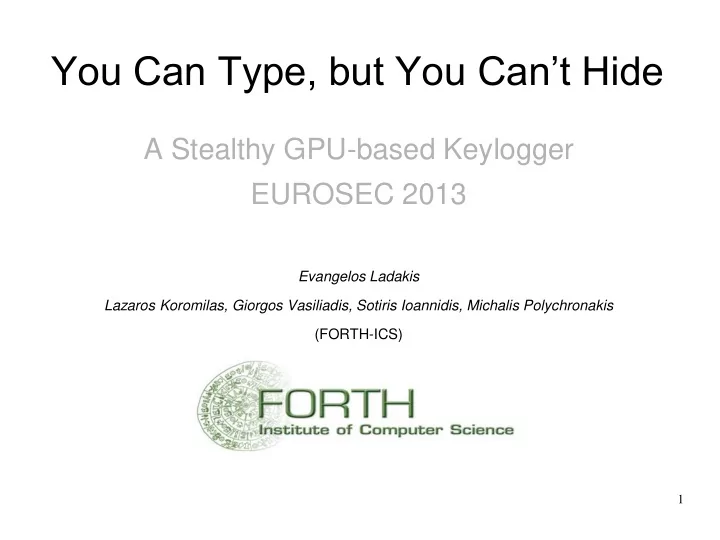

You Can Type, but You Can’t Hide A Stealthy GPU-based Keylogger EUROSEC 2013 Evangelos Ladakis Lazaros Koromilas, Giorgos Vasiliadis, Sotiris Ioannidis, Michalis Polychronakis (FORTH-ICS) 1
Outline Background A GPU-Based keylogger Evaluation Defenses 2
Keyloggers Malware that records keystrokes Types: Hardware (devices plugged in keyboard) Software (user mode or kernel mode) User mode: They use OS functionalities: Character device files Linux OS GetAsyncKeyState Windows OS Kernel mode: They implement “Hook” functions Can be detected by AVs/anti-malware software 3
Motivation How can we hide the malicious code from AVs/anti-malware software? Is it possible to use the GPU for building a stealthier malware? 4
General-Purpose Programming on GPUs (GPGPU) GPUs can be programmed for general purpose computation Familiar API as C language extensions Existing GPGPU frameworks OpenCL (Universal Programming Language) NVIDIA CUDA (For NVIDIA Graphics Cards) General-Purpose Programming is directly supported by most commodity drivers/video cards A GPU-based keylogger will run without problems on most systems 5
Overall approach • Scan kernel’s memory to locate the keyboard buffer • Remap the memory page of the buffer to user space • Set the GPU to periodically read and scan them for sensitive information (e.g., credit card numbers) • Unmap the memory in order to leave no traces 6
Implementation Step 1: Locate the keyboard buffer Keyboard buffer dynamically changes address after system rebooting or after unplugging and plugging back in the device GPU kernel module code manipulate start pages keylogger page table entries scan locate buffer controller memory process scanner 7
Implementation Scan the kernel memory using heuristics Struct URB (USB Request Block) struct usb_device struct usb_device *dev … Must contains substrings ... char* product “USB”, “keyboard” void *transfer_buffer (descibes the device) (actual keyboard buffer) dma addr t *transfer_dma ... u32 *transfer_buffer_length *For proof of concept we scanned kernels memory with a ... kernel module 8
Implementation Step 2: Configure the GPU to constantly monitor buffer contents for changes GPU kernel module code manipulate start pages keylogger page table entries scan locate buffer controller memory process scanner 9
Implementation • The GPU driver allows DMA access ONLY to the host process' address space Only to memory regions allocated through a special CUDA API call • Use a kernel module to remap the physical page of the buffer to the user-level process' memory space 10
Implementation Step 3: Start GPU process & Capture keystrokes GPU kernel module code manipulate start pages keylogger page table entries scan locate buffer controller memory process scanner 11
Implementation • Uninstall the module • Use polling to catch keystrokes “wake up” GPU process periodically through the CPU controller process • Simple state machine translates keystrokes into ASCII characters • Store keystrokes into Video RAM 12
Implementation Step 4: Scan captured keystrokes for sensitive information • GPU-based regular expression parser Credit card Regular expresion VISA ^4[0-9]{12}(?:[0-9]{3})?$ MasterCard ^5[1-5][0-9]{14}$ American Express ^3[47][0-9]{13}$ Diners Club ^3(?:0[0-5]|[68][0-9])[0-9]{11} $ Discover ^6(?:011|5[0-9]{2})[0-9]{12}$ 13
Evaluation • Ubuntu Linux 12.10 with kernel v3.5.0 • Used CUDA 5.0 SDK • Executable less than 4 KB • Polling interval tradeoff: Monitoring granularity vs. CPU/GPU utilization Low Frequency: might miss keystroke events High frequency: might cause detectable CPU/GPU utilization increase 14
CPU Utilization 15
CPU Utilization Fastest Typists 16
GPU Utilization 17
GPU Utilization Fastest Typists 18
Possible Defenses • Monitoring GPU access patterns Multiple/repeated DMAs from the GPU to system RAM • Monitoring GPU usage Unexpected increased GPU usage 19
Current Prototype Limitations • Requires a CPU process to control its execution Future GPGPU SDKs might allow us to drop the CPU controller process • Requires administrative privileges For installing and using the module However the control process runs in user-space • No kernel injection needed or data structure manipulation, in order to hide 20
Conclusion • GPUs offer new ways for robust and stealthy malware • Presented a fully functional and stealthy GPU- based keylogger Low CPU and GPU usage No Device Hooking No traces left after exploitation User Mode application. No kernel injection needed 21
Thank you 22
Locate the keyboard buffer #define __va(x) ((void *)((unsigned long)(x)+PAGE_OFFSET)) for (i = 0; i < totalmem; i += 0x10) { struct urb *urbp = (struct urb *)__va(i); If ( ( (urbp->dev % 0x400) == 0) && ((urbp->transfer_dma % 0x20) == 0) && (urbp->transfer_buffer_length == 8) && (urbp->transfer_buffer != NULL) && strncmp(urbp->dev->product, "usb", 32) && strncmp(urbp->dev->product, "keyboard", 32)) { /* potential match * } } 23
Related Work DMA Malware “DAGGER” by: Patrick Stewin and Iurii Bystrovx Implemented in Intel's Manageability Engine (it is used for remote Bios operations) GPU assisted malware by: Giorgos Vasiliadis, Michalis Polychronakis and Sotiris Ioannidis GPU-based self-unpacking malware 24
Recommend
More recommend